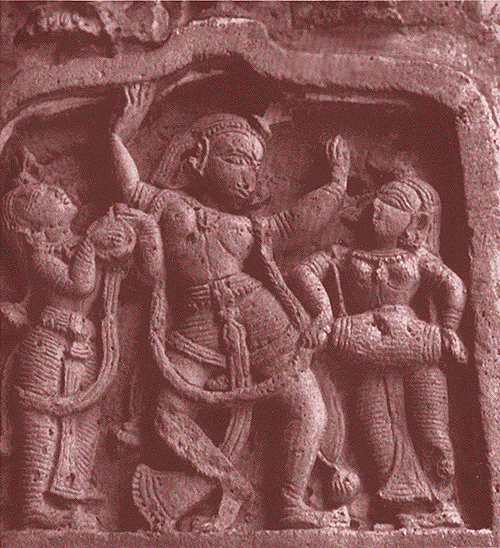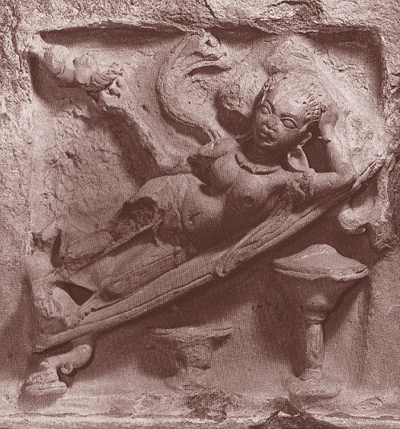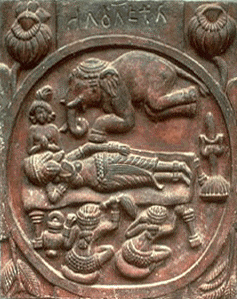Bengali Terracottas - Krsna Dancing
BY: SUN STAFF

Krsna Dancing with the Gopis
Madanmohan Temple, Bishnupur, District Bankura, West Bengal
[ Click for larger version ]
Nov 28, CANADA (SUN) — The terracotta plaque pictured above depicts one of Krsna's boyish pranks (bala-lila), showing Krsna dancing with the gopinis. One gopi is playing on a mrdanga and another on a pair of kartals. A flowing lyricism pervades throughout the whole composition and the ecstasy of expression on the faces of Krsna and the kartal player are simply wonderful.
Although the plaque has suffered some damage from time and the elements, particularly affecting the mrdanga and Krsna's nose, the detail remains intact. These terracotta carvings are amazingly impervious to age, and are a great testament to the skill of the craftsmen who fashioned them.
The town of Bishnupur is also called Mallabhum after the Malla rulers, who were Vaisnavas. They built the majority of West Bengal's famous terracotta temples during the 17th and 18th centuries, many of them in Bankura District. The terracotta temples there are some of the best existing specimens of the classical style of Bengali architecture.
During the 1,000 year rule of the Malla kings, Mallabhum, of which Bankura was a part, became famous not only for its terracotta temples, but also for its bell metal and Baluchari sarees made of tussar silk. Royal patronage also supported the Vishnupuri gharana (school) of Hindustani classical music and the Vishnupur school of painting.
More on the History of Bengali Terracottas
To the later phase of Mahasthan Art, probably belonging to the Gupta era, belongs a remarkable circular plaque illustrating a Mithuna (amorous couple) depicted against the decorative background of lotus-petals. A very interesting find from Mahasthangarh is a terracotta plaque depicting the 'Dream of Maya Devi' (pictured below), which is very skillfully patterned against the square panel by placing the bed diagonally across the plaque. This is a new design, quite different from the primitive illustration of the same theme found at Bharhut (at bottom of page).

In the next stage of Bengali terracottas, we find pieces done in larger sizes and related to architectural structure, such as decorations of the facades of temples.
This form of the art is very well-illustrated in the Mithuna plaque from Mahasthan cited above and also at Paharput, and much earlier, at Gokul (near Mahasthan in Bogra District). Here, many terracotta plaques were found, some bearing architectural and floral patterns revealing the lotus motif, the chequer and the window patterns. Most of these finds are typically 'Gupta' in style.
On the facades of the Chaumukha temple of the Sarvato-bhadra type (of uncertain date, not later than the 8the century A.D.) at Paharpur, we find a large series of beautifully designed terracotta plaques, offering not only lively representations of the early inhabitants of Bengal, but also scenes from the Krsna-lila.

